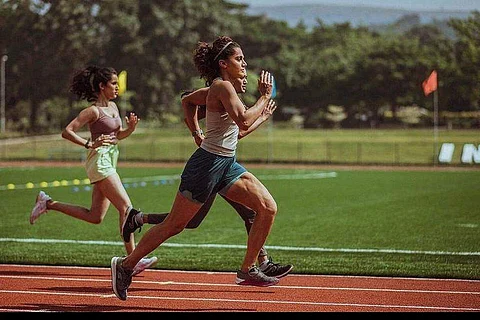Ms Representation: What makes a woman?
Mard Ki Body. This was the comment Taapsee Pannu received when her look for Rashmi Rocket was unveiled. The Pink actor sports a tough, sinewy look to play the role of a medal-winning international athlete. Our society, however, ascribes that description only to a male. Responding to the comment, Taapsee wrote, “Many women actually hear this daily for no fault of theirs. An ode to all the athletes who give their sweat and blood to the sport and their nation and still get to hear this.”
The exchange plays right into the premise of Rashmi Rocket, where Rashmi gets banned from athletics after tests show that her blood has testosterone higher than the levels prescribed by the International Association of Athletics Federations (IAAF). Rashmi goes to court for justice.
She is constantly asked about her gender because her body and sartorial choices do not fit the patriarchal definition of femininity. The film also deals with a graver issue of identity. Intersex women or women with differences in sex development (DSD) naturally develop higher levels of testosterone. It is claimed that this is advantageous to their performance, but this is still contested. Several studies have slammed these regulations citing questionable science. Authorities though claim that these rules exist to 'ensure a fair-playing field’ but what they actually do is put women athletes under duress. Rashmi is subjected to humiliating and invasive tests. Her natural genetic makeup is used to assault her dignity. Rashmi’s identity as a woman is questioned because she doesn’t fit a binary definition of a woman. After her gender test, Rashmi is arrested and assaulted by male policemen because they believe that she isn’t a ‘woman’.
The world of sports has a history of discrimination against women and other vulnerable categories. In the first edition of the Olympics in 1896, women were barred from participation. The founder of the International Olympic Committee (IOC) at that time was quoted to have said Olympics with women would be “impractical, uninteresting, unaesthetic and indecent.” and the games were created for “the solemn and periodic exaltation of male athleticism” with “female applause as a reward.” Over the years, the IOC had to yield to accommodate women athletes, but critics have maintained that it has been careful to not threaten the ‘dominant image of femininity. The 2012 London Olympics was the first time women competed in all sports on the programme.
The story is a fictional narrative inspired by true events—the harassment she faces brings back several stories of women who were hounded after failing the gender test. Dutee Chand (who made history by getting her ban removed at the International Court of Arbitration for Sport) speaks about crying inconsolably for days without food and water after she was declared ‘not a natural woman’ by the media. Shanti Soundarajan attempted to die by suicide after the intense scrutiny and torment she went through. Branded a cheat, she was shunned by the sporting community. Stripped of her silver medal from the 2006 Asian Games, Shanti has spoken about having to wear her hair short and change her dressing style to escape public gaze and judgement. She still hasn’t gotten her medal back.
While the success of male athletes is celebrated, the success of female athletes is often subjected to additional scrutiny. Or as Olympian Veronica Brenner put it in an interview to The New York Times, “We’d hear comments all the time: ‘She’s really strong — she must be part guy.’” It is not new that women in sports are also constantly sexualised, stipulated to wear revealing clothing, unlike their male counterparts. According to an analysis of the Tokyo 2020 Olympics by a US gender justice company, women are ten times more likely to be objectified with a camera angle than male athletes. In the recent European Beach Handball Championships, the Norwegian beach handball was fined for wearing shorts instead of bikini bottoms. Men can afford to be comfortable, but women have to appease the male gaze.
Rashmi Rocket maintains a light tone throughout despite the significance and intensity of the subject at hand. It asks some correct questions: What defines a woman? What is natural? When athletes like Michael Phelps (whose flipper feet and long arms give him an advantage over others) are allowed to compete, why are intersex women curtailed, penalised, and asked to change their bodies? I also loved how motherhood is used in the film: Rashmi’s lawyer uses her pregnancy to raise a question on why a certain bodily function is deemed ‘unnatural for a woman’ while another is crowned as the ‘apex of being female’. However, it doesn’t delve too much into the complexity of the hyperandrogenism debate. Also, for a film that is focused on an athlete with DSD, it is surprising that Rashmi Rocket doesn’t bring up the terminology anywhere.
Taapsee Pannu as Rashmi anchors the film with a powerful performance that neatly balances strength, skill, and vulnerability. She is beautifully supported by Supriya Pathak, Supriya Pilgaonkar, Priyanshu Painyuli, and Abhishek Banerjee. Even though the film loses some of its emotional gravitas by trying to fit into a commercial template, the largely fuss-free narrative helps to keep the viewer engaged. And for once, we get a love story where the man doesn’t automatically become the saviour.
Predominantly, the sports world continues to reflect the patriarchal outlook of society. This is why Rashmi Rocket, despite its shortcomings, is a significant film for representation and an important reminder of the reductive definitions of biological sex and gender, thereby shining light on a neglected demographic.

